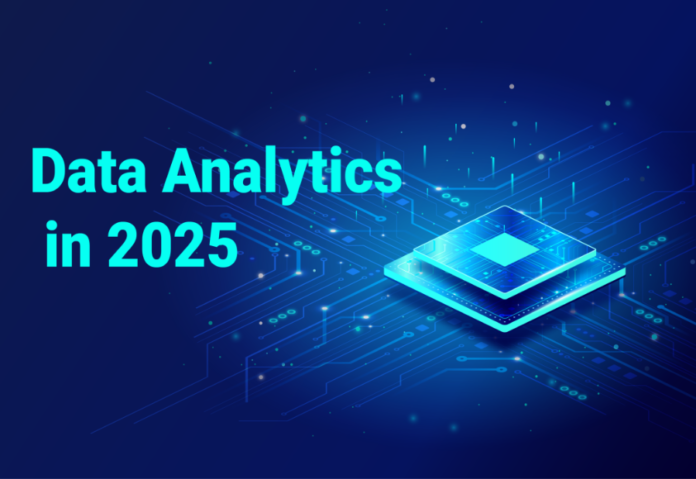Data analysis is changing quickly as a result of previously unheard-of technological and methodological advancements. Data analysts are observing a transition from conventional analysis techniques to increasingly complex, automated, and real-time solutions as 2025 draws near. This change is expected to reshape the function of data analysts and create new opportunities for company strategy, innovation, and decision-making.
This post will discuss some of the major trends that will influence data analysis going forward and what analysts should concentrate on to stay on top of them.
- Rise of Augmented Analytics: AI-Powered Insights
A key component of data analysis will be augmented analytics, which is powered by artificial intelligence (AI) and machine learning (ML). By automating data preparation, analysis, and visualization, these tools free up analysts’ time to concentrate on strategic choices and high-level insights. Without delving into intricate coding, analysts can handle bigger datasets, see patterns more quickly, and even forecast results with AI-powered tools.
What to Expect: Anticipate further platforms with capabilities like automated model creation, natural language processing (NLP) for data querying, and AI-assisted storytelling that aids in elucidating the “why” behind data trends.
- Real-Time Data Analysis for Faster Decision-Making
Real-time data analysis is becoming essential in a time when decisions need to be made quickly. Real-time streaming data analysis enables companies to respond more quickly to operational problems, consumer behavior, and changes in the market. This change is being facilitated by technologies like AWS Kinesis, Google Cloud Dataflow, and Apache Kafka.
What to Expect: Decision-makers will receive actionable insights in a matter of seconds thanks to more automated and user-friendly real-time dashboards. Setting up and maintaining real-time data pipelines and optimizing them for minimal latency will be expected of data analysts.
- Increased Adoption of Cloud-Based Analytics
Although cloud adoption is not new, it is anticipated that nearly all data analytics will be carried out in the cloud by 2025. In addition to facilitating data storage, cloud platforms like Google BigQuery, AWS Redshift, and Microsoft Azure Synapse Analytics are also making complex analytics at scale possible. Cloud platforms’ collaboration, scalability, and adaptability will make them essential for data analysts.
What to Expect: Data will become more available to corporate users from all departments thanks to cloud-based analytics. To handle, examine, and protect data, analysts will need to master cloud-native tools and frameworks.
- Data Democratization and Self-Service Analytics
The days of data analysis being limited to the business intelligence or data science departments are long gone. Self-service analytics will become increasingly popular in the future, allowing corporate users to access and evaluate data without the need for technical knowledge. This movement is being led by tools like Tableau, Power BI, and Looker, which make it simpler for everyone to explore and visualize data.
What to Expect: As “data enablers,” analysts will be responsible for creating data models, selecting datasets, and guaranteeing data accuracy for end users. Analysts will have more time to work on strategic projects and more difficult analytical work as a result.
- The Emergence of DataOps for Analytical Efficiency
The data analytics lifecycle will adopt DataOps, a collection of procedures designed to enhance the caliber, velocity, and teamwork of data analysis. It helps firms decrease data cycle times, increase team collaboration, and improve accuracy by applying DevOps principles to data workflows.
What to Expect: Processes will be streamlined by DataOps, allowing analysts to produce insights more quickly and nimbly. To improve analytical efficiency, analysts must comprehend DataOps frameworks and automation solutions.
- Enhanced Data Privacy and Ethics
Concerns about data security, privacy, and ethics are growing as data analysis becomes more commonplace. Organizations must make sure their data practices are responsible and compliant with laws like the CCPA and GDPR as well as the changing ethical landscape of AI. Analysts must include privacy-by-design concepts into all phases of their data operations by 2025.
What to Expect: Analysts will need to understand ethical AI concepts and data governance. Analytics toolkits will increasingly include tools and platforms that offer consent management, data anonymization, and data lineage monitoring.
- Focus on Data Literacy and Upskilling
Data literacy will become an essential ability in the workplace as complicated technologies and cross-functional collaboration grow more prevalent. In addition to performing analysis, analysts will also be responsible for upskilling other members of the business. Data analysts will become “data educators” instead of “number crunchers” as a result of this change.
What to Expect: Businesses will spend a lot of money on training initiatives to raise team members’ data literacy. Analysts that can lead training sessions, advocate for a data-driven culture, and effectively convey insights will become extremely valued resources.
- Integration of IoT and Edge Analytics
An unprecedented amount of data is being generated by the spread of Internet of Things (IoT) devices, necessitating edge analysis—that is, analysis that takes place closer to the data source. Edge analytics will become more popular because it will enable real-time analysis on gadgets like cameras, smart sensors, and industrial machinery without requiring data to be sent back to a central server.
What to Expect: Working with edge computing frameworks and knowing how to install and keep an eye on models on Internet of Things devices will be prerequisites for data analysts. Real-time data analysis and distributed computing skills will be in great demand.
- Data Storytelling: The Next Big Skill
Storytelling will become increasingly important as data becomes more complex. The ability to create captivating stories around data findings will make analysts stand out. Analysts will connect data with decision-makers using interactive dashboards, infographics, and data visualization.
What to Expect: More interactive storytelling tools will be added as Tableau, Power BI, and Flourish continue to develop. To engage audiences, analysts will need to hone their abilities in data journalism and visual communication.
- The Evolution of No-Code and Low-Code Platforms
Low-code and no-code platforms are facilitating the development of predictive models, analysis, and data pipelines for non-technical users. These platforms will be extensively used by 2025, freeing analysts from tedious coding to concentrate on high-impact jobs.
What to Expect: Analysts will increasingly save programming for complex and unique solutions and employ low-code/no-code platforms for regular work. It will become quite desirable to be proficient in both traditional coding and no-code platforms.
Conclusions: Embracing Data Analysis’s Future
Data analysis has a promising and exciting future full of new challenges and growth prospects. Being ahead of these trends as a data analyst will help you stay current and establish yourself as a key player in the success of your company.
Being flexible is crucial; embrace automation and artificial intelligence, improve your knowledge of cloud computing, keep up with data privacy, and, above all, never stop learning. Data analysts’ roles are changing, and in this exciting new era, people who can combine technical expertise with commercial savvy will succeed.






